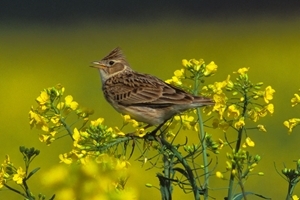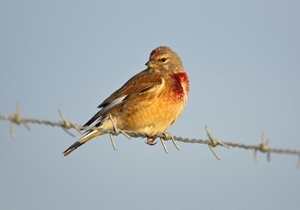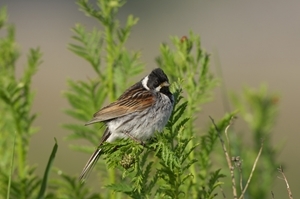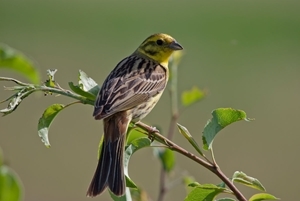Skylark
 The skylark has a very distinctive call, often heard in grasslands and heathland but most common in farmland, as they use the crops for feeding and the bare ground for nesting. They have a unique display flight; the males, being very territorial, use this flight to warn off invaders and call potential mates. They rise almost vertically up where they will sometimes stay for a couple of minutes to share their song before they flutter back down.
The skylark has a very distinctive call, often heard in grasslands and heathland but most common in farmland, as they use the crops for feeding and the bare ground for nesting. They have a unique display flight; the males, being very territorial, use this flight to warn off invaders and call potential mates. They rise almost vertically up where they will sometimes stay for a couple of minutes to share their song before they flutter back down.
Lark shooting was popular in the days of the Victorians, but when they weren’t hunting them they liked to keep male skylarks as songbirds, in captivity. Due to changing farming methods in the early 80s, where weeds were killed more successfully, limiting the weed seeds available, and changing crops choice led to a decline in nesting resources, skylark numbers declined. This brought about widespread conservation concern and work is continuing to ensure the survival of the skylark.
Photo credit: Markus Jenny
Linnet
 Male linnet have a beautiful crimson breast and forehead; the females are more brown and streaky. Linnets live in all sorts of habitats, from scrub and farmland to urban areas, they are quite nervous birds seen low on the ground. They eat grain and weed seeds year-round, especially dandelion seeds. Linnets nest in hedges and gorse bushes. They are smaller than sparrows with a longish forked tail.
Male linnet have a beautiful crimson breast and forehead; the females are more brown and streaky. Linnets live in all sorts of habitats, from scrub and farmland to urban areas, they are quite nervous birds seen low on the ground. They eat grain and weed seeds year-round, especially dandelion seeds. Linnets nest in hedges and gorse bushes. They are smaller than sparrows with a longish forked tail.
Photo credit: David Mason
Reed bunting
 The male bird has a black head and chin with a white collar; the female is streaked with red and brown back and wings. They have a clearly forked tail. They can be seen around farmlands on crops and near water, eating insects and seeds. They particularly like oilseed rape. They lay their eggs in little cup nests either on the ground or up in the crops, and they have been known to fake injury to distract predators from their nests.
The male bird has a black head and chin with a white collar; the female is streaked with red and brown back and wings. They have a clearly forked tail. They can be seen around farmlands on crops and near water, eating insects and seeds. They particularly like oilseed rape. They lay their eggs in little cup nests either on the ground or up in the crops, and they have been known to fake injury to distract predators from their nests.
Photo credit: Laurie Campbell
Yellowhammer
 The beautiful yellow yellowhammer lives its days in farmland with well-managed hedgerows and scrub. They feed on plant seeds including nettles, sorrel, grains and weed seeds foraged from stubble fields. Chicks are dependent on insects. They nest on the ground in dense hedgerows and field margins with long grass, breeding from early spring through to August. They have a distinctive call sounding like ‘ham and cheese please’.
The beautiful yellow yellowhammer lives its days in farmland with well-managed hedgerows and scrub. They feed on plant seeds including nettles, sorrel, grains and weed seeds foraged from stubble fields. Chicks are dependent on insects. They nest on the ground in dense hedgerows and field margins with long grass, breeding from early spring through to August. They have a distinctive call sounding like ‘ham and cheese please’.
Photo credit: Laurie Campbell